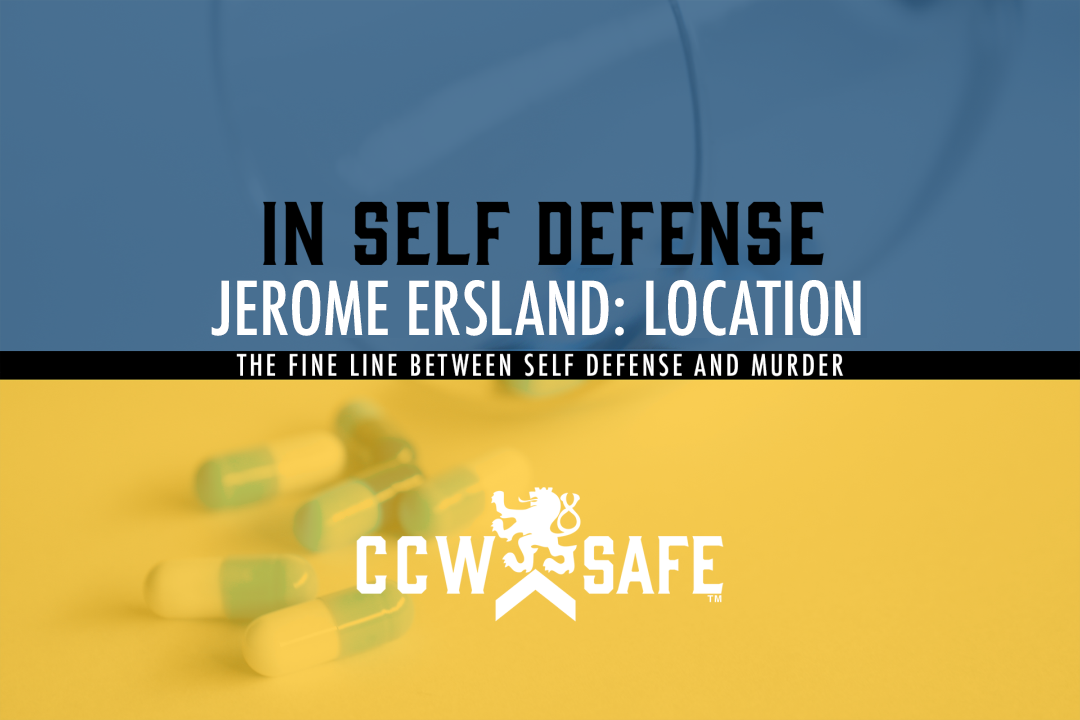
Posted on February 22, 2019
“In Self Defense” The Jerome Ersland Case: The Line Between Self Defense And Murder- Location
The Jerome Ersland Case
The line between self-defense and murder
Part 2: Location
In this installment of “The Four Elements of Self-Defense,” we explore how the location of the shooting affected the legal defense in the Jerome Ersland case. Like most of the shooters we analyze, Jerome Ersland was NOT a CCW Safe member. We’ve chosen his case because it provides clear lessons for concealed carriers regarding what can go wrong in a self-defense shooting.
Jerome Ersland was at work at Reliable Discount Pharmacy when two teens, Antwun Parker and Jevontai Ingram, entered the building and dawned ski masks. Ingram produced a pistol. Their intent was clear.
A career pharmacist, Ersland had been the victim of an armed robbery before. He knew criminals were drawn to pharmacies because of the narcotics stocked on the shelves behind the counter. On this day, May 19, 2009, there was another pharmacist on duty and two technicians. All of their lives were in jeopardy.
Ersland claims the assailants fired at him. He drew a Taurus Judge which he had alternately loaded with .410 buckshot and .45 rounds. A pellet struck Parker in the head, and he fell to the ground. “If I hadn’t been here, there would have been three people killed,” Ersland told reporters. “The other pharmacist and the two techs.”
Ingram fled. Ersland gave chase, firing two or three more times at the fleeing robber. Surveillance video shows Ersland reenter the pharmacy, step over Parker’s body (which was on the ground and out of frame), retrieve another weapon, and shoot Parker five more times. In statements to police, Ersland said he thought Parker was reaching for a gun. He shot the teen because “he wouldn’t go down.”
Forensic evidence at trial suggested Parker had not moved since the initial shot to the head and was lying in an undisturbed pool of his own blood.
District Attorney David Prater charged Ersland with first-degree murder. The prosecution of Ersland sparked public outrage because many in the community felt Ersland was a hero for stopping the robbery and protecting his coworkers.
CCW Safe’s Critical Response Coordinator Gary Eastridge worked with the Oklahoma City DA during the Ersland case, and he said all the angry calls from the community were directed to his desk. “The community was reacting only to that initial, certainly justifiable shooting,” Eastridge says. The public wouldn’t know all the facts until the case moved through the courts.
Don West, veteran criminal defense attorney and National Trial Counsel for CCW Safe says he understands why there was outrage at the initial arrest. He notes that deadly force is justified when there is an imminent threat of death or great bodily harm, but it is also justified to prevent a forcible felony or to protect the lives of others. All three factors were present when Ersland fired the initial shot that incapacitated Antwun Parker.
Moreover, Oklahoma’s self-defense statute, sometimes called the “Make My Day Law,” is like many of the “Stand Your Ground” laws around the country: it removes the duty to retreat from any self-defense claim when the shooter had a legal right to be at the location of the shooting. Outside of your home, there are few places where you have more of a right to be than your place of business. Don West says that investigators, prosecutors, and even juries weigh this fact when determining whether a self-defense shooting is justifiable. He’s calls this idea “forgivable subjectivity,” and he suggests that when someone is strongly entitled to be somewhere, that person may get more of the benefit of doubt.
Forgivable subjectivity only goes so far, however. When Ersland chased Ingram outside and fired down the street, he crossed a line. “The situation changed and morphed,” Eastridge says, “and decisions were made that were less and less justifiable.”
Even the District Attorney agreed the first shot was justifiable, but he told the jury that the final five shots Ersland fired into Parker’s still, incapacitated body was “nothing less than an execution.” The jury agreed, and they convicted Ersland of first-degree murder.
The lesson for the concealed carrier is that although you may get the benefit of the doubt if you’re involved in a self-defense shooting at your place of business, it doesn’t change the law. The law in most states says you may only use deadly force when there is an immediate threat of death or great bodily harm or to prevent a forcible felony. Once the threat has passed and the felony has been prevented, the justification for deadly force disappears as well.
In our series “The Four Elements of Self-Defense,” we explore how location, escalation, reasonable fear, and post-incident actions can affect the legal defense in self-defense shooting. In the next installment, we’ll look specifically at how the concept of “escalation” factored into Ersland’s legal defense.
 |
SHAWN VINCENT- LITIGATION CONSULTANTShawn Vincent is a litigation consultant who helps select juries in self-defense cases, and he manages public interest of high-profile legal matters. If you have any questions for Shawn, or would like more articles like this, let us know belo |